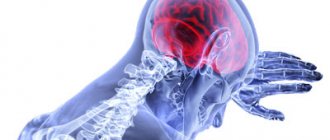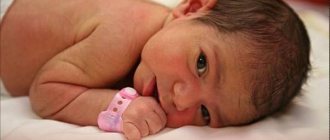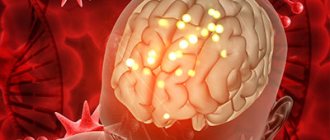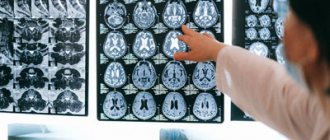Residual cerebral encephalopathy (RE) is a pathological condition caused by organic changes in cerebral structures against the background of ischemia, infections, injuries and other lesions. The severity ranges from minor impairments to severe neurological deficits that cause disability. The most common symptoms are headaches, paresis, autonomic dysfunction, and loss of consciousness. Intellectual and emotional disorders are possible.
To schedule a consultation, contact our operator by phone 8(969)060-93-93.
What is residual encephalopathy? ICD-10 code
The term encephalopathy refers to damage to brain cells of non-inflammatory origin.
This process occurs due to disruption of microcirculation and oxygen starvation of the latter. This leads to the death of neurons with the formation of ischemic foci located diffusely in the cortex and subcortical formations. Residual encephalopathy in children is a “hodgepodge” of symptoms and syndromes that arise against the background of perinatal pathologies or diseases in the first year of a child’s life. Initial signs are usually nonspecific and appear in the first days after birth, but the formation of the final clinical picture, consisting of persistent residual effects, can last several years.
If the reliable cause of the disease is known, then the diagnosis may sound like this: “Residual period of hypoxic ischemic encephalopathy” and in this case the code P91.6 will be assigned. But more often in pediatric neurology situations arise in which the etiology of the disease is unknown. Then the code for the unspecified form of pathology is entered - G93.4.
Symptoms
Manifestations are characterized by significant variability, their nature and severity depend on the prevalence and severity of damage to nerve cells, the compensatory capabilities of the brain and the age of the patient. In infants, signs of encephalopathy of residual origin are increased or decreased muscle tone, unmotivated crying, lack of response to stimuli, or, conversely, frequent episodes of restlessness.
As the child grows, mental retardation, delayed speech development and motor skills are added to the listed symptoms. The presence of such manifestations with sufficient probability indicates the prospect of persistence of residual phenomena throughout life. It should be taken into account that the clinical picture does not always correlate with the severity of brain dysfunction; some signs disappear over time or are eliminated with the help of therapeutic measures.
Subsequently, residual phenomena such as emotional disorders and delayed psychomotor development come to the fore. Children sleep poorly and are characterized by increased tearfulness and irritability. Long-term consequences of perinatal residual organic encephalopathy may include insufficient control over one’s behavior, attacks of aggression, fainting, nausea, vomiting, headache, autonomic dysfunction, poor memory, and decreased learning ability.
Manifestations of the disease can be combined into several neurological syndromes:
- Intellectual-mnestic. Occurs with cognitive impairment, attention and memory disorders.
- Astheno-neurotic. Weakness, increased fatigue, emotional instability, depressive and hypochondriacal tendencies are noted.
- Vestibular-coordinating. Accompanied by dizziness and poor coordination of movements.
- Cephalgic. There are severe headaches.
In adolescent and adult patients, residual encephalopathy may manifest itself as follows:
- frequent migraines that are difficult to relieve with traditional methods;
- emotional lability: apathy, hypochondria, sudden mood swings, causeless crying, increased anxiety, attacks of aggression;
- intracranial hypertension, manifested by headaches, nausea and vomiting;
- autonomic dysfunction: instability of blood pressure, increased or decreased heart rate, sweating;
- insomnia: difficulty falling asleep, frequent awakenings, daytime sleepiness;
- in severe cases - convulsions.
Clinical manifestations of encephalopathy on a residual organic background range from minor to pronounced. In most cases, especially with congenital anomalies, traumatic or inflammatory genesis of the pathology, signs of increased intracranial pressure come to the fore.
A common symptom is persistent cephalgia, peaking in the morning. Characteristic symptoms include nausea and vomiting at the height of a painful attack, weakness, fatigue, blurred vision or spots before the eyes, and difficulty performing intellectual work. Half of the patients have vestibular disorders. Sometimes a decrease in the accuracy of small movements is detected.
Reasons for the development of the condition
Residual encephalopathy of the brain has one global cause. And this is neuronal hypoxia, which is accompanied by the appearance of ischemic foci and edema. But there are many factors leading to this condition. They can act both in the prenatal period and after the birth of the child.
These include:
- severe pregnancy (eclampsia, threatened miscarriage);
- premature birth;
- infectious diseases suffered by the mother during pregnancy or by the baby up to one year;
- The woman is too young (under 18 years old);
- severe toxicosis, especially in the third trimester;
- consumption of alcohol, psychoactive substances, smoking;
- incompatibility of the blood of mother and child according to the Rh factor;
- birth injuries and umbilical cord entanglement;
- a prolonged period of pushing, leading to hypoxia or asphyxia of the fetus;
- action of ionizing radiation.
The presence of such complications and pathologies will not necessarily result in encephalopathy in the future. The child’s brain is extremely plastic; its healthy parts can take on the functions of the affected ones.
Causes
The etiology of EC in children and adults varies, but the underlying cause is always damage to brain tissue. In patients of younger age groups, the disease is most often associated with insufficient blood supply to the brain during gestation, during childbirth and in the first days after birth. The congenital form is provoked by factors such as intrauterine hypoxia, complications during childbirth, birth injuries, and the use of obstetric aids. Heredity, the presence of bad habits in the mother and the age of the pregnant woman play a certain role.
The list of factors that provoke RE in adult patients includes the following conditions:
- chemical dependencies: alcoholism, drug addiction;
- poisoning: salts of heavy metals, insecticides, other toxic substances, often as part of industrial hazards;
- radiation exposure;
- traumatic brain injuries;
- ischemic and hemorrhagic strokes, vascular thrombosis, hypertensive crises;
- cerebral atherosclerosis;
- infectious and inflammatory diseases of the membranes and tissues of the brain: meningitis, arachnoiditis, encephalitis;
- abnormalities in the development of brain structures and cerebral vessels;
- conditions after neurosurgical operations.
Determining the cause of the pathology is associated with some difficulties, since symptoms often appear many years after the adverse effect. In old age, the consequences of injury or infection may be superimposed by hypertension and atherosclerosis.
Classification of residual encephalopathy
The classification of residual encephalopathy is based on the period of development of the child during which the damage to the nervous system occurred. There is a perinatal (congenital) form, which occurs from the 28th week of pregnancy until the end of the seventh day from the moment the baby is born, and an acquired form, which appears later. The first is a consequence of intrauterine development disorders and difficult childbirth, and the second is the result of the influence of infectious agents, toxins, and injuries.
In most cases, it is not possible to distinguish between these conditions, since signs of the disease can be detected several months after exposure to the causative factor.
Causes of residual encephalopathy
The causes of residual encephalopathy vary in children and adults, but this phenomenon is always preceded by damage to brain tissue.
Thus, in children, residual neurological changes can be associated with perinatal ischemic-hypoxic damage that occurs from the 28th week of gestation to the 7th day after birth - intrauterine infection, birth injuries, intrauterine hypoxia, the use of obstetric operations and benefits, abnormalities in the course of labor, etc. d.
Of no small importance in the formation of structural changes in the brain of a newborn is attached to the lifestyle of the expectant mother, bad habits, her age, as well as burdened heredity.
oxygen starvation (hypoxia) in the perinatal period is the main cause of the development of encephalopathy in young children
In adults, the causes of residual encephalopathy are considered to be:
- Traumatic brain injuries, especially repeated ones;
- Alcohol abuse, use of psychotropic drugs and drugs;
- Intoxication with industrial poisons, insecticides, salts of heavy metals;
- Effect of radiation;
- Previous history of hemorrhage or cerebral infarction;
- Frequent hypertensive crises with microinfarctions and vascular thrombosis;
- Progressive atherosclerosis of cerebral arteries;
- Past inflammatory processes in the brain and its membranes;
- Congenital malformations of the nervous system or cerebral vessels;
- Previous surgical interventions on the skull and its contents.
It is not always easy to establish the cause of residual encephalopathy, because symptoms can appear years later, and a person can be affected by various unfavorable factors simultaneously during his life - trauma, intoxication, vascular disorders. In addition, the phenomena of cerebral dysfunction intensify with the addition of atherosclerosis of the cerebral vessels, against the background of hypertension, which fits into the concept of dyscirculatory encephalopathy, therefore the fact of an injury suffered decades ago may well be ignored, and the patient himself may forget or not know what happened to him in early childhood.
Symptoms of the condition in children
Residual encephalopathy in children has many manifestations. The most common of them are:
- violations of the intellectual-mnestic sphere, expressed in mental retardation, poor performance at school;
- hydrocephalus external or internal;
- motor disorders in the form of paresis and paralysis;
- convulsive syndrome.
The presence of certain signs depends on the degree of damage to the brain substance and the location of the main foci of ischemia in it. At the initial visit to the doctor, only one of the syndromes may be observed, but in the absence of adequate therapy, residual encephalopathy tends to progress and over time, existing symptoms will worsen and new ones will appear.
How not to miss alarming symptoms?
The first “bells” of the disease in infants are extremely difficult to identify; a weak or delayed cry after birth, suppression of the sucking and grasping reflexes, and hemodynamic disturbances: heart rate and blood pressure should be alarming. Later the following symptoms are observed:
- irritability, tearfulness;
- sleep disorders - the child either sleeps around the clock or wakes up every half hour;
- hypertrophied reaction to a sharp sound, turning on the light;
- periodic shaking of the whole body;
- frequent persistent regurgitation or hiccups after feeding;
- throwing the head back;
- eye rolling;
- convulsions;
- increased or decreased muscle tone in the limbs.
If the pathology was not assessed in time, then encephalopathy can be suspected in older children:
- delayed psychomotor development;
- appetite disorders;
- dyssomnia (sleep disorders);
- frequent headaches and dizziness;
- mental disorders (apathy, tendency to depression, aggressiveness, decreased criticism);
- an increase in the size of the skull due to hydrocephalus.
Tips for parents
The only thing that can be advised to parents in view of such a disease as residual encephalopathy is to be more attentive to their children. When the first signs of pathology appear, you must immediately contact a specialist, since the sooner therapy is started, the greater the chance of reducing the effect of hypoxia on neurons.
Also, falls of children and infections cannot be ignored - they can cause the death of brain cells, and therefore require timely diagnosis and adequate treatment. The health of children is priceless; it is better to contact the pediatrician once again with a question of interest than to later try to cope with a neglected process.
Manifestations of residual encephalopathy
The symptoms of residual brain changes can be very diverse, and the degree of severity depends on the depth of brain damage and its compensatory capabilities, as well as the age of the patient. In children, signs that some changes in the central nervous system are likely to remain in the future can be noticeable literally from the first days or weeks of life.
Such signs often include convulsive twitching, constant restlessness or lack of response to stimuli, unmotivated crying, increased or decreased muscle tone, delayed motor and mental development, which most likely cannot be eliminated. At the same time, these signs are very subjective and do not always reflect the degree of brain dysfunction, so parents should not panic and specialists should not over-diagnose.
Symptoms of residual encephalopathy can fit into individual neurological syndromes:
- Cephalgic, manifested by intense headaches;
- Vestibular-coordinating, when motor skills and coordination are impaired, dizziness appears;
- Astheno-neurotic - with fatigue, severe weakness, hypochondria, a tendency to depression, emotional lability;
- Intellectual-mnestic disorders - decreased memory, attention, intelligence.
In children, the manifestations may differ somewhat from those listed, especially at an early age, but almost always signs of delayed psycho-motor development and disturbances in the emotional sphere come to the fore as residual phenomena. Young patients get tired quickly, are irritable and whiny, restless and sleep little.
The consequences of mild to moderate perinatal encephalopathy, which was compensated in the first year of life, can be:
- Attacks of aggression or loss of control over behavior and emotions;
- Reduced learning ability, poor school performance, memory disorders;
- Headaches, attacks of nausea and vomiting, fainting;
- Autonomic disorders - sweating, heart rate fluctuations, insomnia, etc.
These symptoms do not fit into a specific disease, such as epilepsy, so many neurologists tend to combine them under the concept of residual encephalopathy.
In adults, symptoms of residual encephalopathy may include:
- Persistent migraines that respond poorly to conservative treatment;
- Signs of intracranial hypertension - nausea, vomiting at the height of headache;
- Sleep disorders - insomnia at night, drowsiness during the day;
- Changes in memory and decrease in intellectual abilities, in severe cases - dementia;
- Emotional imbalance - frequent mood swings, irritability to the point of aggression, anxiety, crying for no reason, hypochondria or apathy;
- Autonomic symptoms - pressure surges, tachycardia or bradycardia, sweating, fluctuations in body temperature;
- In severe cases - convulsive syndrome of varying severity.
In a large proportion of cases of residual encephalopathy, especially if changes in the brain are caused by previous purulent inflammation of the meninges, trauma, or congenital defects, symptoms of increased intracranial pressure appear in the clinic. This is, first of all, a headache that gets worse in the morning, with nausea and vomiting, as well as “floaters” or blurred vision, general anxiety or severe weakness, fatigue and a decrease in the intellectual potential of the brain.
Approximately half of the patients complain of dizziness and the inability to maintain balance when walking, which indicates damage to the vestibular nerve centers. There may be difficulties with writing and making small precise movements.
In general, speaking about the symptoms of residual encephalopathy, it is impossible to identify signs characteristic of this particular pathology. Its manifestations are varied, as is the localization of lesions in the brain. Depending on the individual ability of the body to compensate for the existing defect, symptoms can range from barely noticeable to clearly expressed, but they rarely limit a person in normal daily life activities.
Possible complications
With delayed diagnosis and lack of adequate treatment for the disease, encephalopathy progresses and is accompanied by the appearance of persistent organic brain damage.
As a result, such manifestations of the residual period may develop as:
- symptomatic epilepsy with secondary generalized seizures;
- early onset of Parkinson's disease (tremor, walking impairment);
- cerebral palsy (lack of movement in the limbs, muscle spasticity);
- vegetative-vascular dystonia (fluctuations in blood pressure, pulse);
- oligophrenia (impaired cognitive functions of the brain).
Residual encephalopathy often occurs with impaired speech formation, which leads to difficulties in the child’s socialization processes and entails serious psychological problems.
Prognosis for a child's life
Residual encephalopathy in children is rarely fatal. The prognosis depends entirely on the degree of damage to the brain substance, the age of the child, early diagnosis and treatment. In severe cases, the pathological process involves up to 85-90% of neurons, which promises the patient profound disability.
If the provoking factor was detected and eliminated in time, and restorative therapy was started, then, given the plasticity of the child’s brain, one can hope for a full or partial recovery.
Diagnostic measures
Diagnosis of residual encephalopathy is aimed at identifying its causes and confirming diffuse damage to the brain substance.
For this use:
- physical examination to clarify the neurological status;
- laboratory tests (clinical blood and urine analysis, biochemical blood test, blood sugar test, thyroid hormones);
- EEG to identify epileptogenic foci;
- neurosonography in children under one year of age, since their large fontanel is not yet closed;
- Echo-ES is also an ultrasound method that can help identify signs of hydrocephalus;
- Doppler ultrasound, duplex or triplex scanning of the vessels of the head and neck - to clarify pathology and abnormalities in the development of the circulatory system that can lead to brain hypoxia;
- CT or MRI - these neuroimaging technologies make it possible to detect foci of ischemia, changes in the ventricles and subarachnoid space, and clarify the cause of the observed clinical picture.
The list of diagnostic measures is compiled only by the attending physician after a detailed examination. This will help in some cases to avoid a tomography, since young children will have to be under anesthesia to perform the procedure.
Treatment approaches
Treatment of residual encephalopathy is always comprehensive and is aimed not only at correcting existing symptoms, but also at restoring damaged nerve tissue, protecting functioning neurons from hypoxia and other adverse factors. Treatment methods are always selected individually, taking into account the reasons that caused diffuse brain pathology, the age of the child and the observed clinical picture.
Most often, all manipulations can be performed on an outpatient basis with periodic visits to the doctor. In severe cases of the disease or its steady progression, a hospital stay may be necessary.
Basic treatment methods
The following methods are used in the treatment of residual phenomena of encephalopathy:
- physical therapy;
- physiotherapy (magnetic therapy, electrophoresis, DDT, paraffin therapy, mud therapy);
- reflexology (acupuncture);
- manual therapy and massages;
- diets with limited salt intake;
- occupational therapy and speech therapy for older children;
- exposure to medications;
- neurosurgical interventions (for example, shunting for hydrocephalus).
The positive effect of the carried out set of measures can be noticeable only after several courses of treatment. In some cases, the child has to resort to the help of specialists for many years. After recovery or when the progression of the pathology stops, children are registered at a dispensary.
Medications
Drug therapy prescribed for residual encephalopathy is designed to improve cell nutrition, facilitate oxygen access and restore the affected areas of the brain. For this use:
- vascular drugs (Cytoflavin, Trental, Nicotinic acid) - normalize microcirculation;
- neurometabolites (Cerebrolysin, Cerebrolysate, Cortexin) – contain a complex of amino acids necessary for neurons;
- neuroprotectors (Cerakson, Pantogam, Gliatilin) – protect against hypoxia, restore cell membranes, improve impulse transmission;
- antioxidants (Mexiprim, Mexipridol, Mexicor) – suppress lipid peroxidation and the action of free radicals;
- B vitamins (Milgamma, Neurovitan) – are the “building blocks” of the nervous system;
- anticonvulsants (Carbamazepine, Topiromat, Valprocom) – necessary for the development of symptomatic epilepsy;
- diuretics (Diacarb, Veroshpiron) - reduce increased intracranial pressure against the background of hydrocephalus.
The use of nootropics (Piracetam, Lucetam, Picamilon, Nootropil) is possible only in the absence of convulsive syndrome.
Diagnosis and treatment of residual encephalopathy
Because residual changes may appear many years after the nerve tissue is damaged, diagnosis can be difficult. This requires a thorough examination to rule out all possible other causes of brain dysfunction. The diagnosis of residual encephalopathy requires a scrupulous history and examination - CT brain, MRI, electroencephalography, sometimes lumbar puncture, biochemical blood test, cytogenetic study to exclude chromosomal pathology.
Treatment is prescribed symptomatically, based on the manifestations of the pathology:
- For cranialgia, analgesics and non-steroidal anti-inflammatory drugs are indicated - analgin, ibuprofen, nimesil, etc.
- Diagnosed migraine implies specific anti-migraine treatment with drugs from the triptan group - sumatriptan, amigrenin;
- Means for normalizing the psycho-emotional state and sleep - antidepressants, adaptogens (afobazole, adaptol, persen, melason, sonnate, etc.);
- To improve brain activity, nootropics and drugs that improve metabolism in nervous tissue are indicated - piracetam, fezam, glycine, cortexin, mildronate, etc.;
- For increased intracranial pressure - diuretics (diacarb, veroshpiron);
- To eliminate dizziness, betaserc and its analogues are indicated.
Residual encephalopathy must be treated comprehensively, prescribing not only medications, but also the correct regimen, rest, walks, and adequate physical activity. Sanatorium treatment and medicinal baths are useful; in some cases, patients need to work with a psychotherapist or psychologist.
Children with residual changes are prescribed symptomatic treatment; classes with speech pathologists and child psychologists are advisable. Help from parents who can support and help the child cope with learning and development difficulties is very important.
The prognosis for residual encephalopathy is usually favorable. With treatment, the symptoms gradually weaken and disappear completely, allowing the patient to lead a normal lifestyle, play sports, and work. In more complex cases, you have to put up with some unpleasant symptoms (vegetative dysfunction, headaches). Severe degrees of encephalopathy require a revision of the diagnosis and a different formulation, which will indicate the specific cause and, accordingly, the form of the pathology.
Prevention
Prevention of the development of residual encephalopathy in children consists of:
- regular visits to specialists during pregnancy to identify early signs of pathology, as well as indications for emergency or planned delivery;
- immediate treatment and prevention of various injuries and infections (bacterial, viral, fungal) in a child;
- maintaining a daily routine and physical activity appropriate to the baby’s age;
- proper balanced nutrition;
- the mother’s refusal of bad habits (smoking, drinking alcohol) during pregnancy and feeding.










